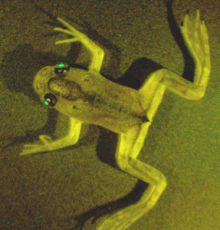Spatiotemporal gene expression
The spatio-temporal gene expression (, spatial-temporal gene expression ') refers to the temporal and spatial differences in gene expression in various cell types during development of an organism.
properties
In contrast to the constantly active household genes , induced genes are only activated at certain times. The gene expression is controlled, among other things, by cell-cell contacts , by changing the cytoskeleton and the extracellular matrix and by gradients of various agonists and antagonists . The initiation of gene expression takes place through binding of transcription factors to the promoter. The cell lineage of the different cell types in the different tissues is based on spatiotemporal gene expression.
Methods
To identify the temporal activation of a promoter, a reporter gene can be inserted after the promoter to be investigated , e.g. B. using the Enhancer Trap method. The spatial distribution of the gene expression of a particular gene in an organism can be examined by in situ hybridization with the mRNA or by immunohistochemistry of the protein . Since both methods have different sources of error , they are often carried out in parallel. In the case of fluorescent reporter proteins , fluorescence microscopy or fluorescence tomography can also be used.
A time-limited gene expression can be achieved by inducible promoters with inducers that do not otherwise occur in the organism, z. B. tetracycline , mifepristone or optogenetics . With microRNA , gene expression can be suppressed for a limited time.
literature
- G. Yang: Bioimage informatics for understanding spatiotemporal dynamics of cellular processes. In: Wiley interdisciplinary reviews. Systems biology and medicine. Volume 5, number 3, 2013 May-Jun, ISSN 1939-005X , pp. 367-380, doi: 10.1002 / wsbm.1214 , PMID 23408597 .
Web links
- FlyBase report of wingless gene expression in Drosophila .
- Spatiotemporal gene expression in the gene vestigator .
- Expression patterns in Drosophila during embryogenesis via in situ hybridization
Individual evidence
- ^ E. Sparks, G. Wachsman, PN Benfey: Spatiotemporal signaling in plant development. In: Nature Reviews Genetics . Volume 14, number 9, September 2013, pp. 631-644, doi: 10.1038 / nrg3541 , PMID 23949543 , PMC 3870141 (free full text).
- ↑ MA Kinney, TC McDevitt: Emerging strategies for spatiotemporal control of stem cell fate and morphogenesis. In: Trends in biotechnology . Volume 31, number 2, February 2013, pp. 78-84, doi: 10.1016 / j.tibtech.2012.11.001 , PMID 23219200 , PMC 3557560 (free full text).
- ↑ CC Valley, CA Lidke, DS Lidke: The spatiotemporal organization of ErbB receptors: insights from microscopy. In: Cold Spring Harbor perspectives in biology. Volume 6, Number 2, February 2014, a020735, doi: 10.1101 / cshperspect.a020735 , PMID 24370847 .


